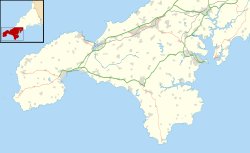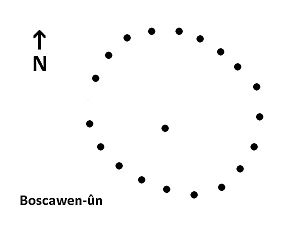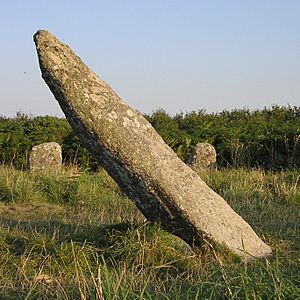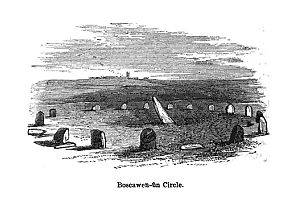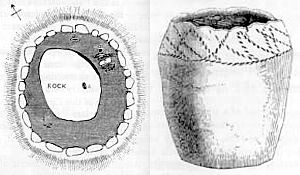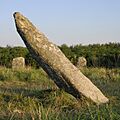Boscawen-Un facts for kids
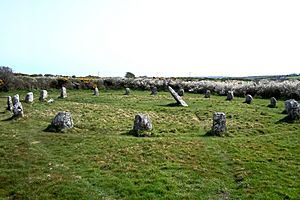
The stone circle in 2011
|
|
| Location | Cornwall |
|---|---|
| Coordinates | 50°05′23″N 5°37′08″W / 50.08978°N 5.618847°W |
| Type | Stone circle |
| History | |
| Periods | Neolithic / Bronze Age |
| Site notes | |
| Ownership | CASPN |
Boscawen-Ûn is an ancient stone circle from the Bronze Age. You can find it near St Buryan in Cornwall, UK. This special place has nineteen standing stones arranged in an oval shape. In the middle, there's another stone that leans to one side. There's also a gap on the west side of the circle, which might have been an entrance.
The oval shape of the circle measures about 24.9 meters (81.7 feet) by 21.9 meters (71.9 feet) across. Boscawen-Ûn is also important because the Gorseth Kernow (a group that celebrates Cornish culture) started here in 1928.
Where is Boscawen-Ûn?
Boscawen-Ûn is located in the southwest part of Cornwall. It's in an area called Penwith, just north of St Buryan. You can find it close to the A30 road, which goes from Penzance to Land's End. From this spot, you can even see other famous stone circles like the Merry Maidens and the two Pipers standing stones. You can also see the sea from here!
The name "Boscawen-Ûn" comes from the Cornish language. "Bos" means "farmstead," and "scawen" means "elder" or "elderberry tree." The "Un" at the end means "an adjacent pasture." So, the name means "the pasture of the farmstead at the elderberry tree."
How Was It Built?
The Boscawen-Ûn stone circle has a large central stone. Around it are 19 other stones. Most of these are made of grey granite. But one stone is made of bright white quartz. This quartz stone is in the southwest part of the circle. Its position might show the direction of the sun as it moves south after a time called Samhain (an ancient festival).
The circle itself is shaped like an oval. It measures about 24.9 meters (81.7 feet) long and 21.9 meters (71.9 feet) wide. At the northeast edge, there are two stones in the ground. These might have been part of an old burial place.
The big central stone has special carvings on it. These carvings look like feet or axes. Such carvings are quite rare in the United Kingdom. You can also see similar ones at Stonehenge. The carvings on the central stone are fully lit by the sun only around the summer solstice sunrise. They get some light during the summer sunset too. The whole circle seems to be lined up with the rising sun during the winter solstice.
There's a wide gap on the west side of the circle. Some people think this means stones are missing from there. However, it could also have been an entrance, just like at the nearby Merry Maidens stone circle. The central stone is 2.7 meters (8.9 feet) long. But because it leans so much towards the northeast, its top is only 2.0 meters (6.6 feet) above the ground.
History of Boscawen-Ûn
The stone circle at Boscawen-Ûn was built a very long time ago, during the Bronze Age. It's thought that a group of poets and storytellers, called a Gorsedd, might have met in this area. Old Welsh writings from the 6th century AD mention a Gorsedd "of Beisgawen of Dumnonia." This was named as one of the three most important Gorsedds in Britain. Dumnonia was an ancient kingdom that likely included Cornwall.
In 1928, the Gorseth Kernow (Gorsedd of Cornwall) was started at Boscawen-Ûn. This happened during a time when people were working to bring back the Cornish language and culture. Henry Jenner founded this Cornish Bard Association.
One of the first people to write about the stone circle was William Camden. In his book Britannia (around 1589), he described it. He said there were nineteen stones in a circle, with one much larger stone in the middle. Camden didn't mention the central stone leaning. But in 1749, William Stukeley thought someone might have moved it while looking for treasure.
Later, in 1754, William Borlase drew a map of the circle. His map showed eighteen stones standing and one that had fallen. At some point in the next 100 years, a Cornish hedge (a type of stone wall) was built right through the circle. This hedge was first mentioned in 1850.
Around 1862, the owner of the land, Miss Elizabeth Carne, had the hedge removed. She then had a new hedge built around the stones instead. This was one of the first times someone actively worked to protect an ancient site. In 1864, the area around the stone circle was studied scientifically for the first time. Reports from these studies showed that the central stone was already leaning a lot back then.
During these studies, a burial mound was found near the stone circle. Inside it, archaeologists found urns (pots that held ashes). From this time, we have one of the first pictures of the stone circle. It was drawn by John Thomas Blight for a book about churches in Cornwall. He also drew a map of the burial mound and a sketch of one of the urns found.
Images for kids


